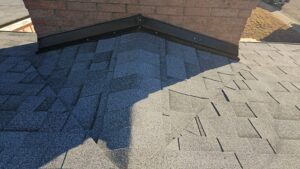In Colorado’s unpredictable climate, even the smallest roof design detail can make a big difference in long-term performance. One of the most effective features for keeping your roof watertight is a chimney cricket—a simple yet powerful addition that helps prevent leaks and structural damage around one of your roof’s most vulnerable areas.
If your home has a chimney that sits on a sloped roof, installing a chimney cricket is more than a best practice—it’s a protective upgrade worth considering.
What Is a Chimney Cricket?

Also known as a chimney saddle, a chimney cricket is a small, peaked structure built behind a chimney where it meets the roof slope. This triangular “mini-roof” is designed to divert water, snow, and debris away from the base of the chimney, preventing moisture buildup that can lead to leaks and long-term damage.
Crickets are especially important for chimneys more than 30 inches wide, where water can easily become trapped behind the vertical chimney wall. Without one, water can pool in this hard-to-see area, infiltrate shingles, and cause wood rot, mold, or interior water stains.
Chimney Cricket vs. Chimney Saddle: Is There a Difference?
If you’ve heard both terms used and wondered whether there’s a difference—you’re not alone. Technically, the “saddle” refers to the lower space where the sloped roof meets the back wall of the chimney—much like a saddle between two peaks. It can also refer to the triangular-shaped flashing that rests in that intersection.
However, “chimney cricket” remains the term most commonly used in roofing today to describe the small, roof-like structure installed behind the chimney that physically redirects water away from this junction.
While the origins of the word “cricket” remain unclear, most professionals use it interchangeably with “saddle.” But make no mistake: this structure plays a critical role in roof performance, particularly in climates like Colorado’s, where snow and rain are persistent concerns.
Without a saddle or cricket in place, water flowing down from the ridge can get trapped against the chimney wall, leading to:
- Erosion of brick and mortar
- Moisture infiltration under shingles
- Deterioration of roof decking and attic insulation
To learn how chimney crickets support the integrity of your roof as a whole, explore our residential roofing solutions.
Why Are Chimney Crickets So Important?
1. They Protect the Chimney
Brick chimneys, while durable, are vulnerable to water infiltration. Constant runoff from rain and snow can erode mortar and brick surfaces over time, eventually allowing water into the chimney flue. A chimney cricket keeps water moving away from the masonry, extending the life of your chimney.
2. They Protect the Roof
When water gets stuck behind a chimney, it puts unnecessary strain on your shingles and underlayment. Over time, this can lead to leaks, warping, or even structural damage to your roof deck. A properly built cricket keeps water flowing safely off your roof and into the gutter system—where it belongs.
Custom-Built for Performance
Chimney crickets aren’t one-size-fits-all. Each one must be customized to your roof’s pitch, chimney width, and height. Typically, the cricket is framed with treated wood and covered with metal—often galvanized steel, aluminum, or stainless steel for superior weather resistance.
While the cricket improves water redirection, it works best in tandem with other flashing types, such as step flashing and counter flashing, to ensure total moisture protection around the chimney base.
For comprehensive protection, explore our residential roofing services.
What Does It Cost to Install a Chimney Cricket?
The total cost of adding or replacing a chimney cricket can vary depending on:
- Chimney size
- Roof slope and complexity
- Material selection
- Labor and accessibility
In Northern Colorado, professional installations generally range from $3,000 to $5,500, but a proper estimate should be based on an on-site assessment. While it may seem like a significant investment, the long-term protection can prevent far more expensive repairs down the line.
Wondering whether it’s time for more than a cricket? Learn the top signs it’s time for roof replacement.
Is It Required by Code?
In many jurisdictions, chimney crickets are required by building code for chimneys wider than 30 inches. Even when not required, they’re strongly recommended by roofing professionals for long-term roof and chimney performance—especially in areas with heavy snow or rain.
For reference, see IRC 2021 Chapter 10: Chimneys and Fireplaces.
Professional Installation Matters
Installing a chimney cricket isn’t a weekend DIY project. It requires precise measurements, knowledge of water flow, and high-quality construction materials. Improper installation can do more harm than good, leading to roof damage, code violations, or voided warranties.
At Schroeder Roofing, we’ve been building and maintaining roofs in Northern Colorado since 1977. Our experienced team ensures chimney crickets are seamlessly integrated into your roof system, delivering both protection and peace of mind.
We also specialize in roof repairs and full roof replacements when more comprehensive solutions are needed.
Don’t Wait for a Leak—Prevent One
If your home has a chimney on a sloped roof, it may be time to consider a chimney cricket—especially if you’ve noticed signs of water damage, ice buildup, or leaking after storms. A quick inspection from our team can determine whether your roof could benefit from this often-overlooked upgrade.
